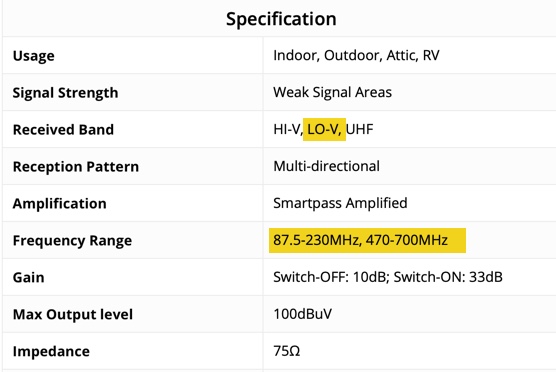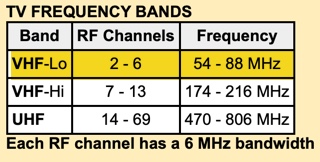You know I was looking at something like that someone made with pvc pipe …
I hadnt checked AVS yet to see how people in the boston area were dealing with it … but again thank you…!
I am no antenna expert but how “directional” would this need to be, I can’t imagine it would be overly sensitive to orientation other than being parallel to the ground, elevated, and “roughly” in the direction of the broadcast tower…
got the AVS forum link to this discussion? …
Thanks! …
My thought is if this worked, it might be easy enough to install in the attic and just run a coax to the amp (which has a VHF input – unused at the moment)… (the db8e is outside and roof mounted, but I have a few unused cable feeds from when I had an attic install of a lesser yagi type antenna)
1 Like
Wouldn’t have to be directional since it is so long. I calculate that the wire would be 156 inches long or 78 inches on each side when folded.
Yep attic.
Here is a pic of someone’s channel 6 (Philly) just strung up from rafters:
1 Like
People are also commenting on other stations affected by the repack at AVS such as WBZ.
that looks like a coat hanger… but it looks a lot less then 100+ inches assuming the rafters are standard 16" width.
Yea I got the thread up now and following it… that is exactly what info I was looking for… I really appreciate it… (those guys know more about the issue so this info is good) …
If you find anymore more, please either post it or DM it to me…
BTW this is my favorite using copper pipes. I built one using copper refrigeration coil from Home Depot.

FWIW back in 2012 we lived in Philly for a short time and I learned the hard way about ch6 being hard to get… fortunately we were only there a few months … wasn’t till before we left I found rabbit ears worked best.
At least you have a chance with ch 5. People are getting it. Ch 6 in Philly is really hard to get!
Yah, it looks like he did a half-wave hoping that would work rather than a full wave. Ch 5 would be 156 inches full wave, 78 folded in two.
Here’s another LO VHF design (hourglass loop):
http://imageevent.com/holl_ands/loops/lovhffmhourglassloop
Holl_ands is a good source (I’ve used his designs).
As the FCC changes our channel frequencies, there may be signal strength variations. Please be assured that WGBH is working hard to improve the signal strength for WGBH and the HD signals it carries. Your email will be used to demonstrate that viewers are having difficulty receiving our signal. We will be petitioning the FCC for a “Maximization of Power” and this will help you receive our HD channels, but we need viewers like you to help in that effort.
BTW I’m familiar with the Boston area. Did some consulting work in Cambridge Mass twenty years ago. My wife and I loved visiting New England and Ogunquit (Maine).
Shoot, there goes your reason for getting an Antop 
1 Like
Kind of negates the marketing implication, you need a specialized HD antenna. Or there is something extraordinary with an antenna labeled HD.
That’s not to say modern designs and engineering haven’t enhanced their abilities. In the end, it’s “conductive” to attract RF signals. 
The best antenna that’s ever been made - the Channel Master 4251 - predates the HD era.
The problem about the Antop is that there appear to be contradictory statements about it. The Amazon blurb says it covers the full VHF range (channels 2-13). However the Antop website says it starts at 87 MHz. Channels 2-6 are under 87 MHz.
If the Amazon description is right then an Antop user wouldn’t need a specialized antenna to go along with it.
But experience tells me that a small antenna like the Antop would have difficulty receiving LO VHF signals. Until someone tests it with LO VHF, we won’t know which one of the technical descriptions is true. Not many people have LO VHF stations in their area so I haven’t found any reviews that validate the Amazon claim…
1 Like
Seems there is some contradiction here. Antop claims LO VHF but barely covers that.
I have this antenna and it does receive HI-VHF great, There are no LO-V stations near me.
ANTOP 400BV


I think there has been an ambiguous use of the word “low” in the industry and at forums. Some people refer to any channels in the lower range as “low” (including HI VHF) while others use the word “low” specifically for LO VHF.
It’s entirely possible that someone just a few miles away from a LO VHF transmitter could get a LO VHF channel with an Antop. After all some people get LO VHF with normal rabbit ears that are not extended for LO VHF. But if somebody is 30 to 50 miles away, how does an Antop respond to a LO VHF signal? Hard to figure out…
Also in @ericgus case, the LO VHF channel (5) is also petitioning the FCC to increase their power. Could an Antop get LO VHF if the broadcaster is transmitting at increased power? Perhaps…maybe that’s why their specifications are so ambiguous.
BTW I’ve been thinking that the VHF rods Antop gives for VHF reception as an addon could be modified and extended for LO VHF by transforming them into a folded dipole (half-wave).
Thanks for all the info. I have enough problems getting a HI VHF channel with a Clearstream 4V, LO VHF would be a nightmare.
Why do you think the Boston OTA users are up in arms over a repack to LO VHF?! The $200 million PBS received in Boston to move over is really a bone of contention among users. And remember PBS stations have a backup strategy for complainers…just use our streaming app for $10 a month… Just as CBS is suggesting to use their CBS All Access streaming app during the blackout. Is TV exciting or what these days
Just as CBS is suggesting to use their CBS All Access streaming app during the blackout. Is TV exciting or what these days 
The Repack…brought to you by the Cell Phone (teenage babysitter)…




 Just as CBS is suggesting to use their CBS All Access streaming app during the blackout. Is TV exciting or what these days
Just as CBS is suggesting to use their CBS All Access streaming app during the blackout. Is TV exciting or what these days 